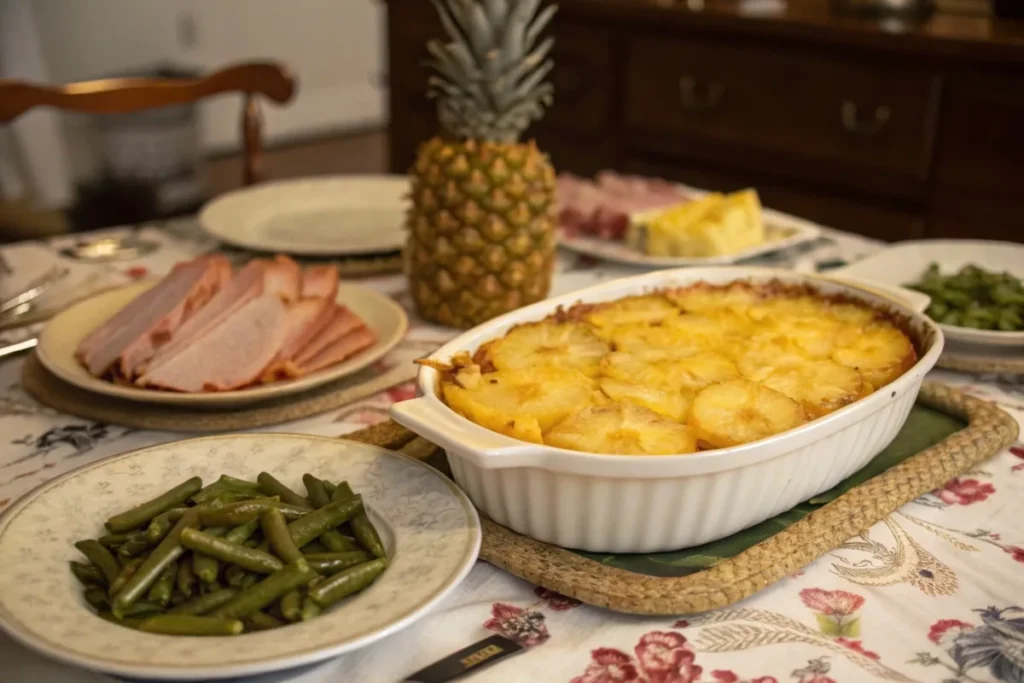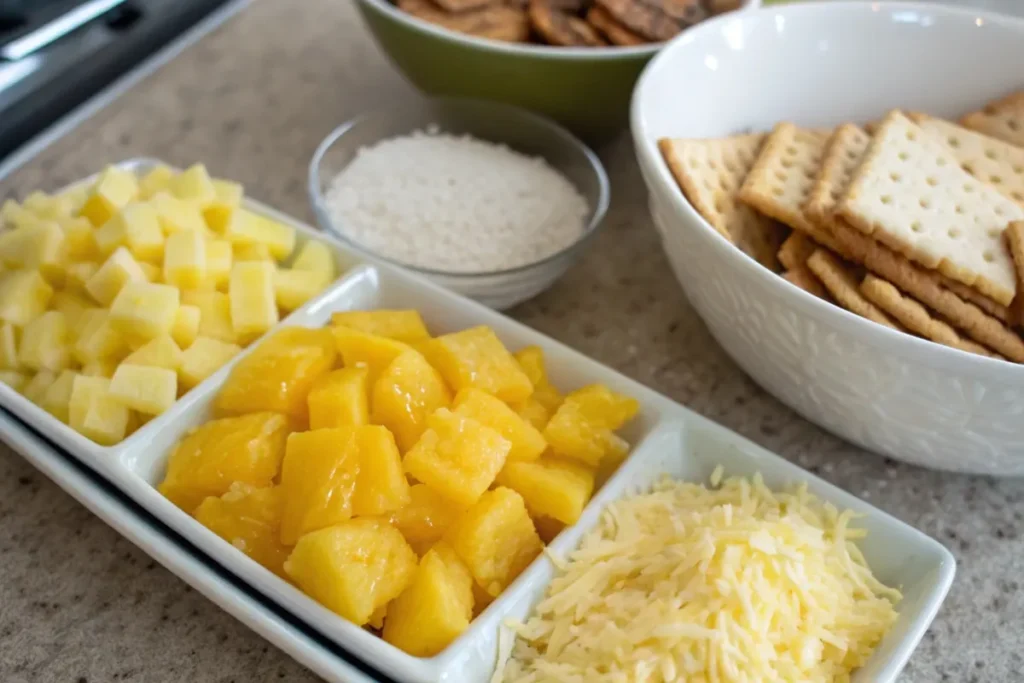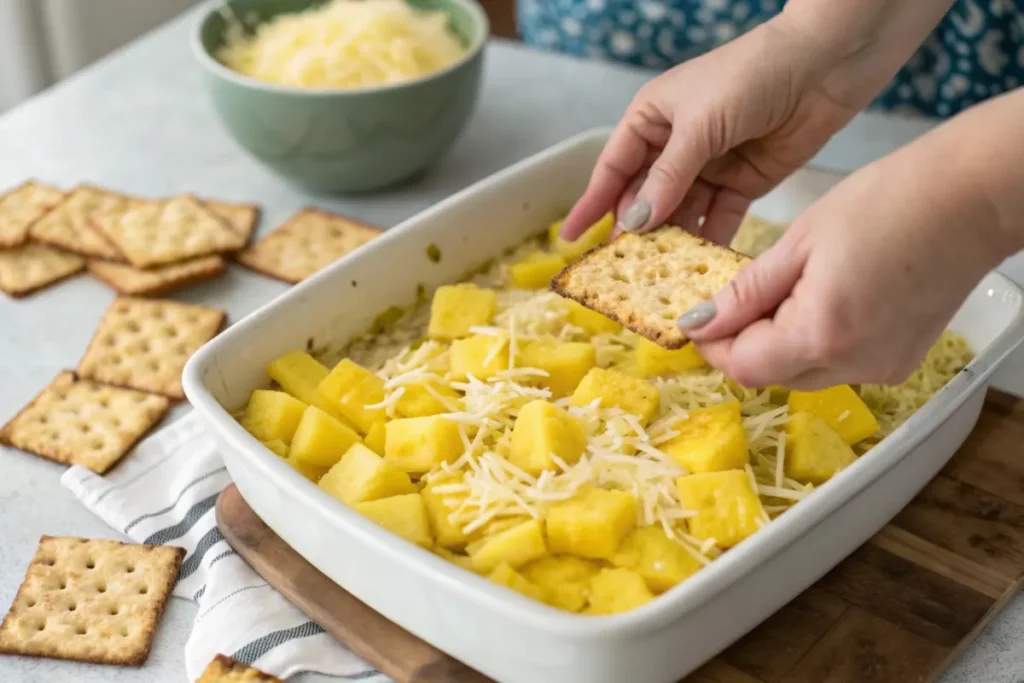Who says comfort food can’t be a little adventurous? If you’re tired of the same old side dishes, pineapple casserole is here to shake up your table with its delightful blend of sweet and savory flavors. Imagine warm, juicy pineapple chunks baked to perfection with buttery crackers and gooey cheese—sounds intriguing, right? First, it’s ridiculously easy to prepare, making it a go-to option for busy weeknights or last-minute gatherings. Next, it’s surprisingly versatile, pairing beautifully with everything from roasted chicken to holiday ham.
What’s more, this dish isn’t just a crowd-pleaser; it’s a conversation starter. Your guests will be asking for the recipe before dessert even rolls around! Whether you’re a seasoned home cook or just starting, pineapple casserole offers that perfect mix of simplicity and wow factor. So, are you ready to try something new? Stick with me as we dive into the magic behind this Southern classic—you won’t want to miss a single detail!
Table of contents
- Discovering the Unique Charm of Pineapple Casserole
- The Perfect Blend of Sweet and Savory Flavors
- Step-by-Step Guide to Making Pineapple Casserole
- Creative Variations on the Classic Pineapple Casserole
- Serving and Storing Pineapple Casserole Like a Pro
- Frequently Asked Questions (FAQs)
- Wrapping Up: Why Pineapple Casserole Deserves a Spot on Your Table
Discovering the Unique Charm of Pineapple Casserole
Origins and History of Pineapple Casserole
Pineapple casserole has an origin story as fascinating as its taste. This Southern classic combines unexpected ingredients, like sweet pineapple and savory cheese, into one unforgettable dish. Born out of a love for bold, comforting flavors, it gained popularity at potlucks and family gatherings across the South. In the past, creative cooks often relied on pantry staples to craft unique dishes. Pineapple casserole is a testament to their ingenuity. The dish is believed to have first appeared in the mid-20th century when Southern cooking embraced a mix of sweet and savory pairings. Over time, it became a holiday favorite, symbolizing tradition and community. First, it’s easy to make, and second, it brings people together. The combination of textures and flavors also makes it stand out from other casseroles. If you’ve never tried pineapple casserole, you’re in for a treat! It’s like a culinary time capsule of Southern charm.

How This Dish Became a Southern Favorite
What makes pineapple casserole such a beloved Southern staple? Its ability to transform simple ingredients into a dish full of flavor and comfort. Families across the South often include it at Easter, Thanksgiving, or Christmas meals. But it’s not just for holidays! This casserole is also a hit at everyday dinners and summer picnics. The blend of pineapple’s sweetness and the savory crunch of crackers has won over many hearts. Word-of-mouth and community cookbooks helped spread the love for pineapple casserole far and wide. Plus, it’s versatile. You can serve it as a side dish with ham or chicken or even as a dessert. People love its balance of familiar and surprising flavors. It’s no wonder that once people try it, they keep coming back for more. Pineapple casserole is truly one of those dishes that defines Southern hospitality and flavor.
The Perfect Blend of Sweet and Savory Flavors
Key Ingredients That Make Pineapple Casserole Stand Out
The magic of pineapple casserole lies in its unique mix of ingredients. Each one plays an important role in creating its signature taste. First, there’s the pineapple. Whether canned or fresh, its natural sweetness is the star of the show. Next, we have shredded cheese—cheddar is the go-to choice. It might sound unusual, but trust me, the tangy sharpness complements the pineapple perfectly. Then there’s the topping. Buttery crackers, like Ritz, are crushed and mixed with melted butter to add a crunchy finish. Sugar enhances the sweetness, while a pinch of salt balances the flavors. The result? A dish that’s sweet, salty, tangy, and buttery all at once. It’s the kind of flavor combination you didn’t know you needed. Plus, the ingredients are easy to find, making this dish simple to whip up anytime. Once you try it, you’ll see why it’s such a hit.

Why Pineapple Works Wonderfully in Savory Recipes
Pineapple might seem like an odd addition to savory dishes, but it’s a culinary powerhouse. First, its natural sweetness adds depth to savory flavors. Then there’s its texture. Pineapple chunks soften during cooking, creating a juicy contrast to crunchy toppings like crackers. Also, pineapple pairs exceptionally well with cheese. The tangy sharpness of cheddar balances the fruit’s sugary notes. Additionally, pineapple’s acidity enhances the other ingredients, much like lemon or vinegar in other recipes. Its versatility means it can hold its own in salads, pizzas, or even casseroles. Pineapple casserole showcases this balance beautifully, with its perfect blend of sweet and salty. Once you taste how pineapple elevates savory flavors, you’ll see why it’s a Southern favorite. If you’ve never paired pineapple with cheese or crackers before, get ready for a delicious surprise. It’s like a flavor party you didn’t know you needed.
Step-by-Step Guide to Making Pineapple Casserole
Preparing the Ingredients for the Ultimate Flavor
Making pineapple casserole starts with prepping the right ingredients. First, gather your pineapple—canned chunks in juice are the most common choice. Drain the juice, but don’t toss it just yet. Then, grab your shredded cheddar cheese. You’ll want a good-quality cheese that melts smoothly and adds a rich, tangy flavor. Next, it’s time to prepare the buttery cracker topping. Crush your crackers into small, even pieces and mix them with melted butter for that perfect crunch. Finally, measure out sugar and a pinch of salt to balance the sweetness. Once you have everything ready, layer the pineapple and cheese in your baking dish. Sprinkle the sugar and salt evenly over the top before adding the buttery cracker mixture. The preparation process is simple and quick, making this dish a breeze for any home cook. With just a few steps, you’ll be ready to bake.

Cooking Tips to Achieve the Perfect Texture
When it comes to baking pineapple casserole, texture is everything. First, preheat your oven to ensure even cooking. Then, use a baking dish that distributes heat evenly—glass or ceramic works best. As the casserole bakes, the pineapple becomes tender and juicy, while the cheese melts into a creamy layer. Meanwhile, the cracker topping turns golden brown and irresistibly crispy. To avoid sogginess, make sure to drain your pineapple well before layering it. Also, spread the cracker topping evenly so every bite has that crunchy goodness. Bake at a moderate temperature, usually around 350°F, for about 25-30 minutes. Keep an eye on the topping—if it browns too quickly, cover it loosely with foil. Once the casserole is bubbling and the topping is perfectly crisp, it’s ready to serve. Following these tips will guarantee a pineapple casserole with spot-on texture every time.
Creative Variations on the Classic Pineapple Casserole
Adding a Personal Touch with Unique Ingredients
One of the best things about pineapple casserole is how easy it is to make your own. First, consider swapping cheddar cheese for a milder option, like mozzarella, if you prefer less tang. Next, try adding a sprinkle of cinnamon or nutmeg for a warm, spiced twist. For those who love extra crunch, mix chopped pecans into the cracker topping. You can also experiment with other fruits. Adding a handful of sliced strawberries or diced apples gives a fresh, fruity boost. Want to make it more savory? Toss in some cooked bacon bits for a salty kick. The beauty of pineapple casserole is that you can change it up however you like. It’s a dish that invites creativity while still being deliciously comforting. Whether you stick to tradition or add your own flair, pineapple casserole is sure to impress.
Pairing Pineapple Casserole with Other Dishes
Pineapple casserole is versatile enough to complement a variety of meals. First, it pairs wonderfully with savory proteins like glazed ham, roast chicken, or pork chops. The sweetness of the casserole balances out the rich, hearty flavors of these meats. Then, it works well as part of a holiday spread, sitting proudly alongside stuffing, green beans, and mashed potatoes. For lighter meals, try serving it with a crisp green salad or roasted vegetables. In addition, pineapple casserole can even shine as a dessert! Its sweet, fruity base makes it a delightful treat with a scoop of vanilla ice cream on the side. The possibilities are endless. Whether it’s a family dinner or a festive feast, this dish adds a touch of Southern charm to any menu. You’ll love how easily it fits into your meal plans.
Serving and Storing Pineapple Casserole Like a Pro
Presentation Tips for Impressing Your Guests
Serving pineapple casserole is your chance to wow your guests. First, let the casserole cool slightly after baking to allow the flavors to settle. Then, consider presenting it in a beautiful baking dish that matches your table setting. If you’re hosting a gathering, garnish the top with fresh herbs or a sprinkle of cinnamon for an elegant touch. Next, portion the casserole into individual servings to make it easy for guests to enjoy. For a more casual meal, let everyone help themselves straight from the dish. The golden-brown topping and juicy pineapple filling create a stunning contrast that’s as eye-catching as it is delicious. Adding small details, like colorful serving utensils or matching plates, can make your meal feel extra special. Presentation isn’t just about looks—it’s about creating a memorable experience. With these tips, your pineapple casserole will steal the spotlight.
Best Practices for Storing Leftovers
If you’re lucky enough to have leftovers, pineapple casserole is just as good the next day! First, transfer it to an airtight container or cover the baking dish tightly with plastic wrap. Then, store it in the refrigerator for up to three days. When you’re ready to enjoy it again, reheat the casserole in the oven at 350°F until it’s warmed through. The cracker topping might lose some of its crunch, but you can refresh it by adding a sprinkle of fresh crumbs before reheating. If you prefer, you can also freeze pineapple casserole for longer storage. Simply wrap it securely in foil or plastic and freeze for up to three months. Thaw it overnight in the fridge before reheating. Storing leftovers properly ensures you can savor every bite, even after the meal is over.
Frequently Asked Questions (FAQs)
What kind of cheese goes with pineapple?
Cheddar cheese is the go-to choice when pairing with pineapple. Its tangy, bold flavor balances the sweetness perfectly. First, it creates a delightful contrast that makes each bite exciting. Next, cheddar melts beautifully, adding a creamy texture to dishes like pineapple casserole. If you’re feeling adventurous, you can also try mozzarella or cream cheese. Mozzarella offers a milder taste, while cream cheese adds richness. In addition, cheeses with a hint of sharpness, like Monterey Jack, work wonderfully too. Whatever cheese you choose, the key is to let it complement the pineapple’s juicy sweetness. You’ll love the results!
Can canned pineapple be used instead of fresh?
Yes, canned pineapple works perfectly for most recipes, including pineapple casserole. It’s convenient and already peeled, cored, and cut. First, it saves time, especially when you’re in a rush. Also, canned pineapple has a consistent sweetness, making it reliable for recipes. Choose pineapple in juice rather than syrup for a fresher flavor. If you prefer fresh pineapple, that’s great too—it offers a slightly firmer texture and natural taste. Both options are delicious, so it’s all about what’s easiest for you. Whether you use canned or fresh, your dish will turn out amazing every time.
What food can be made from pineapple?
Pineapple is incredibly versatile and works in both sweet and savory dishes. First, you can use it in desserts like pineapple upside-down cake or smoothies. Then, it’s fantastic in savory dishes like pineapple casserole or grilled with chicken. It’s also great in tropical salsas, paired with fish or tacos. Pineapple can elevate a salad, adding juicy sweetness to leafy greens. Plus, it’s a star ingredient for pizzas, stir-fries, and even skewers. In addition, it’s delicious on its own as a refreshing snack. With so many options, pineapple proves it’s the ultimate kitchen multitasker.
Why do you cook pineapple?
Cooking pineapple enhances its flavor and texture, making it even more delicious. First, the heat softens the fruit, giving it a melt-in-your-mouth feel. Next, cooking brings out its natural sweetness and caramelizes the sugars. This creates a richer, more intense flavor. Also, cooking pineapple balances its acidity, making it less sharp. It’s perfect for baked dishes like pineapple casserole or grilled alongside savory proteins. In addition, warm pineapple pairs beautifully with spices like cinnamon or ginger. Whether you’re baking, grilling, or sautéing, cooking pineapple adds a special touch that transforms any dish into a treat.
Wrapping Up: Why Pineapple Casserole Deserves a Spot on Your Table
Pineapple casserole is a delightful dish that blends sweet and savory flavors in the best way. It’s simple to make, packed with unique textures, and perfect for any occasion. First, the juicy pineapple adds sweetness, while the buttery crackers and melted cheese bring richness and crunch. Then, its versatility means you can serve it as a side, dessert, or even the star of the meal. In addition, this dish isn’t just delicious; it’s a crowd-pleaser that sparks conversation. Whether you’re hosting a holiday feast or a casual dinner, pineapple casserole adds charm to your table. Give it a try—you’re going to love it! With minimal effort and maximum flavor, it’s sure to become a family favorite. So, why not add a little Southern magic to your next meal? Pineapple casserole is ready to win you over, one delicious bite at a time.
